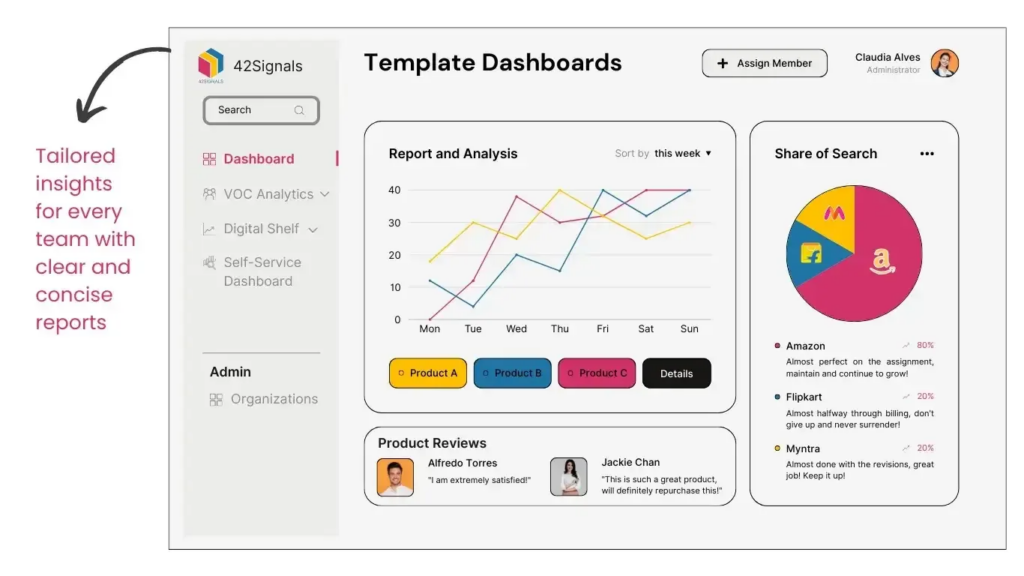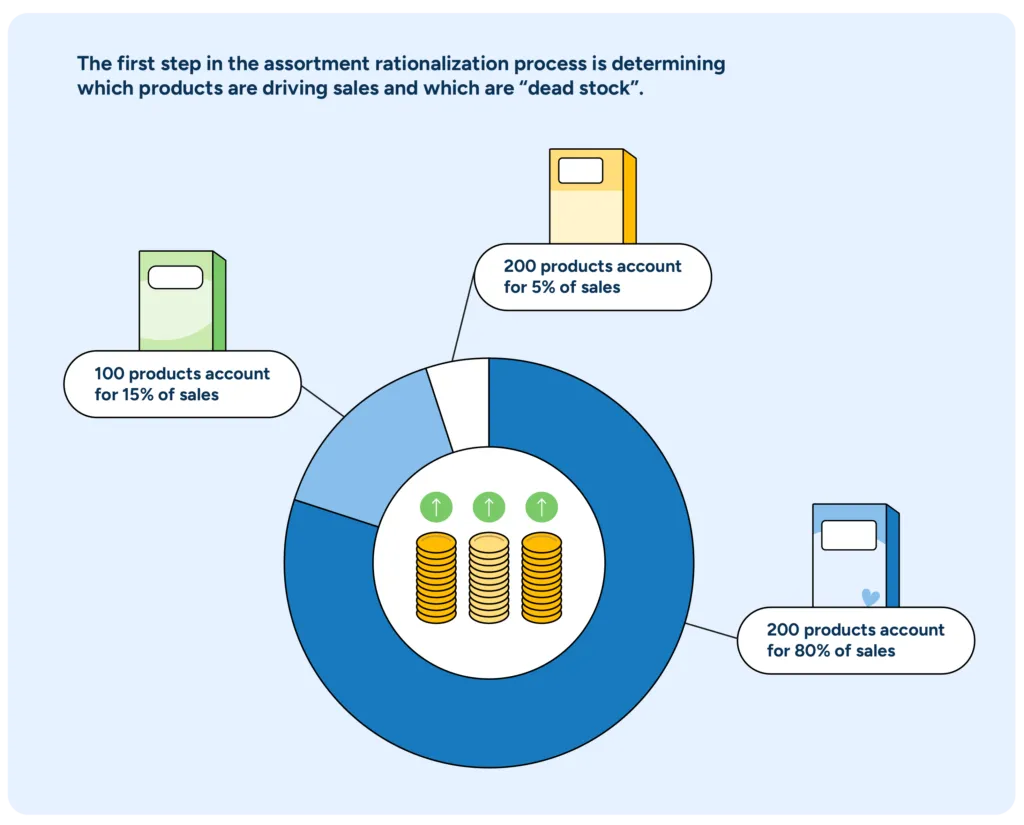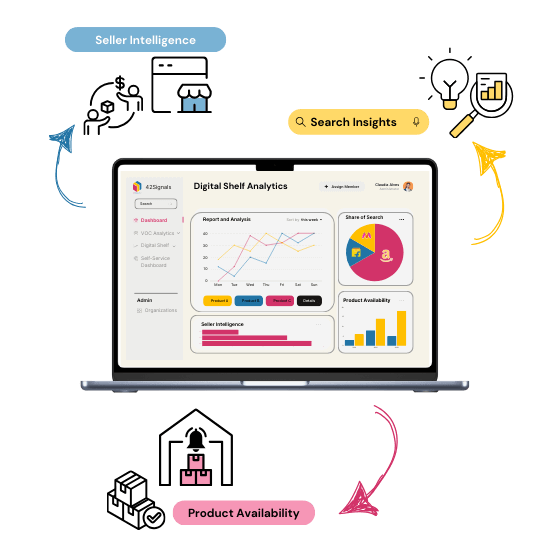What Role Does E-Commerce Analytics Play in Curating Product Offerings?
E-commerce analytics encompasses a range of tools and techniques used to gather, analyze, and interpret data from online shopping platforms. This data can provide insights into customer preferences, buying behavior, and competitive performance, among other metrics. It can also be used to craft or tailor strong product offerings.

For product strategy, e-commerce analytics provides a valuable foundation.
Brands use analytics to assess which products are driving revenue, analyze customer feedback, and identify emerging trends.
This insight is critical for businesses in sectors like electronics, apparel, and home goods, where consumer preferences can change rapidly due to trends, new technologies, or seasonal factors.
Product strategy is the process of identifying a brand’s target customers, understanding their needs, and creating a roadmap to deliver products that meet those needs.
With the help of e-commerce analytics, brands can craft product offerings that align more closely with customer demands, creating products that are not only popular but also strategically beneficial to the business.
Why E-Commerce Analytics Is Key to Strong Product Offerings?
E-commerce analytics offers numerous benefits that support the development of compelling product offerings. Here are some of the key advantages:
1. Informed Product Development
One of the first steps in product development is understanding what the customer wants.

Image Source: Anurag Wadehra
Through data collected on customer preferences and purchasing patterns, e-commerce analytics can reveal valuable insights about what consumers look for in a product.
For instance, apparel brands can analyze popular styles, colors, and sizes, while electronics companies can gauge the demand for specific features, like battery life or processing speed. This knowledge enables product development teams to prioritize the most desirable features and characteristics in their new products, improving the chances of market success.
2. Product Assortment Optimization
Product assortment optimization is the process of selecting the right mix of products to offer customers.
With ecommerce analytics businesses can identify high-performing and underperforming products, enabling them to make informed decisions about which products to keep, modify, or remove from their assortment.

Image Source: Relex Solutions
Apparel retailers, for example, can use analytics to focus on stocking popular items while phasing out styles that have low demand.
In the electronics sector, brands can see which product variations, like color or storage size, resonate best with their audience. Home goods companies can assess the performance of various categories, such as furniture versus kitchen items, to better manage their inventory.
3. Leveraging Digital Shelf Analytics
Digital shelf analytics (DSA) focuses on monitoring how products are displayed on e-commerce platforms, including visibility, positioning, and pricing.

It is essential for today’s shoppers because the “digital shelf” is often the first and only place customers interact with a product before making a purchase decision.
DSA provides insights into how effectively a product’s digital representation is optimized for conversions. It can reveal if products are appearing in search results if the listings are attracting clicks, and how frequently they are viewed and purchased.
4. Enhancing Customer Feedback Collection
Customer feedback is a powerful asset for refining product offerings.
E-commerce analytics can streamline the process of gathering and analyzing customer feedback. Reviews, ratings, and social media comments provide a wealth of information about customer satisfaction and areas for improvement.
By systematically collecting and analyzing this feedback, brands can pinpoint pain points in their products.
For example, if customers frequently mention that a particular electronic device has a short battery life, the brand can prioritize improving that feature in future product iterations.
How Do Businesses Use E-Commerce Analytics to Improve Product Offerings
Let’s understand how ecommerce analytics can be applied in the real world to create strong product offerings.
1. Apparel Industry
In the apparel industry, customer preferences are incredibly fluid, with trends changing by the season or even faster. Through e-commerce analytics, clothing brands can identify which styles, colors, and fabrics are in demand.
By analyzing purchase patterns, companies can determine whether certain items are more popular in specific regions or among certain demographics.
For instance, an apparel company might find that brighter colors are trending in warmer months, prompting it to introduce seasonal collections that cater to this demand.
Additionally, analytics can reveal insights into sizing preferences, helping brands refine their size range to minimize returns due to poor fit.
2. Electronics Sector
The electronics market is characterized by fast-paced innovation, where the latest technology can quickly render existing products obsolete.

E-commerce analytics allows electronics companies to identify which features are most valued by consumers, such as camera quality in smartphones or processing speed in laptops. By focusing on these key areas, companies can ensure their product offerings align with consumer expectations.
For instance, if an electronics company sees a surge in demand for wireless earphones, it might prioritize the development of similar products or expand its current assortment.
Digital shelf analytics can highlight whether certain products are underperforming due to a lack of visibility on search pages, guiding companies to refine their listing strategies.
3. Home Goods
In the home goods sector, consumer preferences can vary widely based on lifestyle, home size, and personal taste.
E-commerce analytics helps brands understand which categories (e.g., kitchenware, furniture, or decor) are trending and what specific items within those categories are most sought after.
For example, a home goods company might notice a rising interest in sustainable products, such as furniture made from recycled materials.
Armed with this knowledge, the company could focus on expanding its eco-friendly product offerings to cater to this demand. E-commerce analytics can also reveal regional differences in preferences, helping companies tailor their assortment to different markets.
How E-Commerce Analytics Drives Continuous Improvement?
Brands need to consistently monitor analytics data to stay attuned to changes in consumer behavior and market conditions.
Here’s how continuous use of e-commerce analytics supports long-term success:
- Adapting to Seasonal Demand
Analytics can help identify seasonal trends, enabling brands to adjust their product offerings accordingly.
For instance, home goods retailers might see a rise in demand for outdoor furniture during the summer and shift their focus accordingly. Seasonal adaptation is particularly relevant in the apparel industry, where changing weather and fashion trends influence demand.
- Identifying New Market Opportunities
E-commerce analytics can highlight emerging trends that a company may not have previously considered.
For example, if analytics data shows an increase in demand for “smart home” devices, an electronics brand might consider expanding its range to include smart locks, thermostats, or lighting systems.
- Improving Customer Satisfaction and Retention
Analytics can reveal common pain points and areas for improvement in product offerings. By addressing these issues, brands can increase customer satisfaction, reduce returns, and improve brand loyalty.
For example, in the apparel industry, a brand might introduce a flexible return policy for items that are often returned due to sizing issues, enhancing the overall customer experience.
Conclusion
E-commerce analytics provides an invaluable resource for brands looking to create strong product offerings that resonate with consumers.
Fine-tuning the development process that delivers products meeting customer needs is the right investment to building a product that people will continue purchasing.
We help clients of all sizes with their market analytics and product data needs to make the right improvements and upgrades based on actual customer data.
Schedule a demo to know more.



